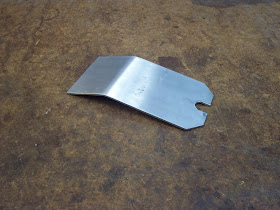There's just one little problem -- the filter is 20"x20"x1"[2], and our furnace takes 16"x20"x1"[2] filters.
 Now, how hard can it be to resize one of these things? Let's see what I can do with a straightedge and a sharp utility knife.
Now, how hard can it be to resize one of these things? Let's see what I can do with a straightedge and a sharp utility knife.- - -
That went fairly well. Here's a shot of the cut off end of the filter, and of how I'm trimming the glue off the end cap that I've peeled/sliced away.
 The filter is well-constructed of quite tough materials, and the manufacturer didn't scrimp on glue.
The filter is well-constructed of quite tough materials, and the manufacturer didn't scrimp on glue.What I have in mind is to reattach the end cap with hot-melt glue. I should end up with a reasonable facsimile of a 16"x20" filter.
- - -
That turned out not too shabby at all. Here's a close-up view of one end of the reattached cap.

So, should you come across an oversize filter, or a whole truckload of oversize filters at a really good price, snap them up -- they're not difficult to modify to fit.
- - -
[1] I can't seem to find a price for this exact filter, but from what I've seen, the retail price of these things is outrageous.
I'll grant that they're well made of excellent materials, and I have no reason to dispute what's claimed for the things, but just how well must I be protected from every conceivable pollutant in this world to go on living in it? How did the human race ever get past cave-dwelling without Honeywell cave-fire filters to keep it healthy?
The paper wrapper that was on the filter tells me that, "This filter cleans the air of: pollen, household dust, auto emissions, mold spores, animal dander, bacteria, particles that can carry viruses [!?], smog particles." Or, to put it another way, possibly, "Be afraid! Spend lots of money on our filters and we'll protect you.
[2] The nominal dimensions of these filters are just that -- nominal; they're all made slightly undersize so they'll fit easily in their racks.
The Honeywell unit states actual dimensions of 19 5/8"x19 5/8"x13/16". The mesh filter I have is similarly undersize, though it doesn't state actual dimensions; it just gives a metric equivalent of its nominal dimensions (406mm x 508mm x 25mm).
# # #
# # #






















